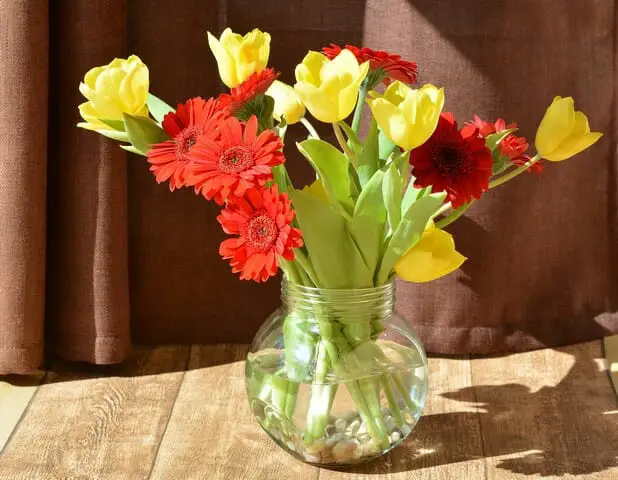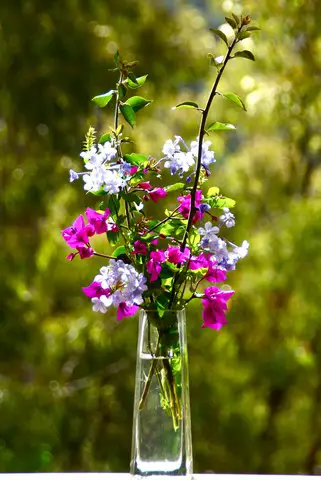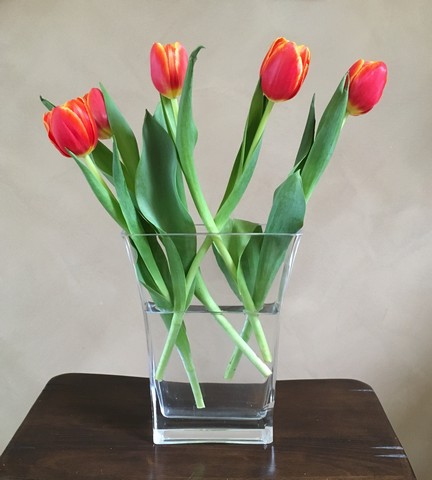Last Updated on May 19, 2022 by Grow with Bovees
Can you imagine a life without flowers? Just consider the pure joy that a beautiful bunch of cut flowers brings.
But, in reality, how long can flowers go without water? The most popular question being; how long do roses last without water?
Not only does a vase of flowers brighten up your home, but a beautiful fresh bouquet of flowers also makes a lovely gift.
Not quite so lovely though, if they’ve already wilted by the time you hand them over.
Luckily, there are specific things you can do to extend their life, whether purchased from a local florist or picked from your own garden.
The big questions are; exactly how long do flowers last without water? And how do you make them last longer?
Let’s take a look at the recommendations from the Bovees research team…..
Longevity Of Fresh Flowers
If external factors from the environment are optimal, most flowers can last for a few hours without water. Some flowers, however, may last a bit longer than others without water.
The types of flowers that can stay alive a bit longer are those that have sturdy and woody stems and strong petals, because they are able to hold onto water for longer.
One example is the lily. It has a sturdy and woody stem and thick petals that are able to hold onto water for longer than most.
Bulb flowers such as the tulip, on the other hand, will not last long if left without water. They have quite delicate stems and petals, which are unable to store water over longer periods of time.
Environmental Factors & Flower Life
The lifespan of a flower that does not receive water is also affected by its surrounding environmental factors such as the temperature. It is therefore important to keep this in mind when giving or receiving a bouquet of flowers.
Hot Weather
If the day is hot and humid, flowers that are left without cold water tend to wither and die quickly. The first step towards longevity is to place them in a vase with water at the first opportunity you can. Whether you have just received them, or as a temporary storage measure before giving them.
Cold Weather
The colder the surrounding temperature is, the longer that bouquet flowers last without water.
Cool weather and cold temperatures sustain their life.
Tips For Keeping Flowers Without Water Alive And Flowers Fresh Overnight
Taking care of cut flowers properly and placing them in water immediately you buy or receive them can lengthen their life considerably, bringing a burst of color to your house for as long as 7-12 days.
But that isn’t always possible.
If you purchase a bouquet of flowers which you cannot place in a vase of water yet, simply wrap the stems in wet paper towels covered with a plastic bag.
If the stems are wrapped in paper towels that are wet, your cut flowers may then still have a chance of lasting for up to 5 days without water as the water on the wet towel stops the ends of the stems drying out.
If you will only be able to display your flowers in a vase in their final position the next day, or you have bought them in advance to give to somebody on a special occasion, then you can keep the flowers fresh overnight by placing them in the fridge.
Having said this, it is important to keep them away from ripening fruits, as the ethylene that they produce shortens the life of flowers.
Cut Flowers That Last the Longest Without Water
When choosing which varieties of flowers to purchase, it is worth keeping in mind that some flowers naturally last longer than others, as we have already mentioned, some flowers are more sensitive than others; including roses and tulips.
Here are a few flower types that are rated among the top ten flowers able to survive for longer without water.
- Protea
- Anthurium
- Lilies
- Orchids
- Thistles
- Lisianthus
- Standard rose varieties
- Spray roses
- Chrysanthemums
How To Keep Flowers Fresh for Longer – Cut Flowers Care Guide
Even though there are flowers that can survive quite some time without water, it is always best to place them in a decorative vase and provide them with some TLC as soon as possible if you want them to stay pretty and colorful.
In this next section, we will cover some other tips on how to keep your cut flowers looking fresh and vibrant for longer.
The Source of the Flowers
If you are lucky enough to be able to grow flowers in your own garden, then you have the added advantage of being able to control their environment and treatment from the moment they are cut, and even before that.
How you transport flowers can also play a major role in their longevity. Flowers purchased from a store may have been through all sorts of trials and tribulations, before you buy them, that will shorten the length of their vase life.
Not only do home grown flowers have advantages in longevity, but also, the pleasure of picking flowers, as and when you like, far outweighs any extra trouble it takes to grow them.
Pick At The Right Time Of Day
The best time to cut flowers is in the late afternoon when it is cool, after 4 o’clock.
The sugar content of the plant has built up during the day and the flowers will last longer than if picked in the morning.
They may also be picked in the early morning before moisture after they have taken up moisture during the night and before the day heats up, but never in the middle of the day.
It is best to place the picked flowers in a bucket of cool water overnight and to arrange them the following morning. Preferably out of doors, in summer, where they can be kept cool,
The Condition of The Flower
Whether selecting from a shop or from your own garden, go for those with the strongest looking stems, a good healthy color and nice pert looking leaves and flower heads.
Pick Them at The Right Stage of Development
Different species of flowers benefit from being picked at different stages of their development.
Roses should be picked when the buds have loosened but are not fully open.
Flowers of the daisy family; such as Chrysanthemums and Daisies, should be picked when fully open.
Carnations should be picked when three-quarters open.
Poppies should be picked in bud just before the flowers begin to open.
Gladioli and Irises are best picked in bud but with the lowest flowers just open.
Making The Initial Cut
When making the initial cut, or when trimming flower stems after they have been in a vase for a day or two, make a cut at an angle.
It is important to make the cut at an angle so that the stem does not rest squarely on the bottom of the vase and prevent water from entering.
It is also important to use the right cutting tool; a clean,sharp knife or a pair of scissors.
Cleanliness is very important to prevent introducing bacteria to the environment
Fiskars have some excellent snips for cutting flower stems (Amazon link).
When picking flowers it is a good idea to carry a small can of water and immediately place the stems in it instead of into a basket.
Getting The Flowers Off To A Good Start
Flowers absorb more water in the first few hours after picking than at any other time, so if you didn’t put them in water the moment you picked them, it is a good idea to place them in a container of fairly deep water as soon as you get inside, as a temporary measure while you start to prepare your vase or arrangement vessel.
When you do this, it is also a good idea to snip off another 1/4 inch (6 mm) whilst keeping the end of the stem under water, in order to get rid of air-bubbles.
Make sure the vase is clean before using it to place flowers in water.
Using a mild bleach solution and warm water is a great way to clean it thoroughly.
When you place your flowers in your vessel of choice, make sure the flowers stems are sitting in as much water as possible without their leaves being submerged in the water.
When flower leaves sit in water, they will likely promote the growth of bacteria, causing the flowers to rapidly decay.
In fact, if you have other foliage that you are going to put in the vase/arrangement as well, then it is a good idea to remove all foliage on the flower stem itself to reduce unnecessary transpiration which will make the flowers last longer.
For roses, it is very handy to use a rose stripper to remove the thorns and skin at the same time from the lower 2 centimeters of rose stems.

Removing the thorns makes it easier to arrange the roses, as thorns have a tendency to catch on other stems as you insert them into the arrangement.
Flowers with stems that ooze sap like; Poppies, Daisies and Dahlias, or flowers that have milky latex like Poinsettia should have their stems burned or boiled in order to prevent the escaping juices from clogging the stem openings.
The easiest way is to bunch the stems together and singe the ends in the bare flame of a gas fire or candle.
Take care not to allow the heat to play on the flowers.
Otherwise, pour an inch of boiling water into a jug and stand the stems in it, leaving them until the water cools. Be careful not to allow steam to reach the petals.
Flowers with woody stems like; Hydrangeas, Chrysanthemums and many flowering shrubs, absorb water better if the bark on the base of the stem is peeled off, or the base is crushed or the end split upwards with the pruners.
Aftercare In The Vase
Once in the vase, cut a small piece off the stem on a daily basis, again using a clean sharp knife or scissor[a]s. Trimming the stems to expose fresh cells helps the stem draw up water.
Remove the faded flowers in the vase. This is important, again from a bacteria point of view, as the faded blooms will start to decay and grow bacteria.
Replace old water with new water every day. Flowers appreciate a fresh drink of water. For regular flowers, use lukewarm water and for bulb flowers, use cold water.
To revive wilting flowers you can cut off the ends of the stems (again, underwater) and put them into some tepid water for a couple of hours before putting them back in the arrangement.
Tricks of the Florist Trade
One can also add things to the water in order to prolong the life of the flower.
Flower Food
A little sugar in the water prevents the loose petals of Larkspur and Delphinium from falling and is also recommended for Asters and Chrysanthemums.
Adding some plant food or flower food to your flower water is also a good investment. Organic fertilizer is great to use.
Add A Copper Coin or Hydrogen Peroxide
A copper coin placed in the water is thought to prolong the life of some flowers. The copper acts as an acidifier, which will delay the production of any bacteria, thereby making the blooms last up to five days longer.
Adding a little food grade hydrogen peroxide to the flower water, will do the same job.
Use a Spray For Flowers to Last Longer
Using an anti-transpirant spray on your cut flowers is another method for making them last longer.
This is a clear, protective coating that reduces the amount of moisture that can escape through the foliage of the plant.

It is a clear soft and flexible film that you won’t notice, but has a considerable effect on the moisture loss of your cut blooms.
You can also use it on your potted Christmas tree to make it last longer, and on other plants to protect them from things like sun scald and wind burn.
Just one spray application is all you need from this ready to use spray gun applicator.
Position of the vase
Every good florist knows that you’re supposed to keep your flowers in a cool place. This doesn’t just help them last longer, it also helps them stay looking better for longer.
In short, position-wise, your blooms will last best in the coolest part of the room and out of direct sunlight.
In fact, if your arrangement is kept at a temperature of around 4 °C (39 °F), they will stay fresh for up to a week longer than they would at a warmer temperature.

Misting them lightly with an atomizer during hot and/or dry weather will also help to keep them fresh.
All plants need a good supply of oxygen in order for them to breathe and stay fresh for longer.
If your arrangement is inside a box or cellophane packaging of some sort, simply poke tiny holes in it, so that the oxygen can circulate around the bouquet.
Conclusion
Beautiful blooms brighten up any room, or mood, for that matter. And such beauty should definitely be put on display and preserved for as long as possible.
The basics are; remembering not to keep your fresh flowers without water for any longer than you absolutely have to, and certainly giving them water at the first sign of wilting.
Those two, along with all the additional information above, we are confident, gives you all the knowledge you need to make your fresh cut flowers last longer.
References:
https://www.usgs.gov/special-topics/water-science-school/science/evapotranspiration-and-water-cycle
